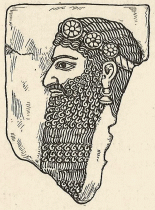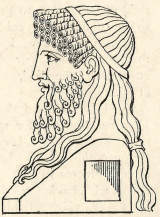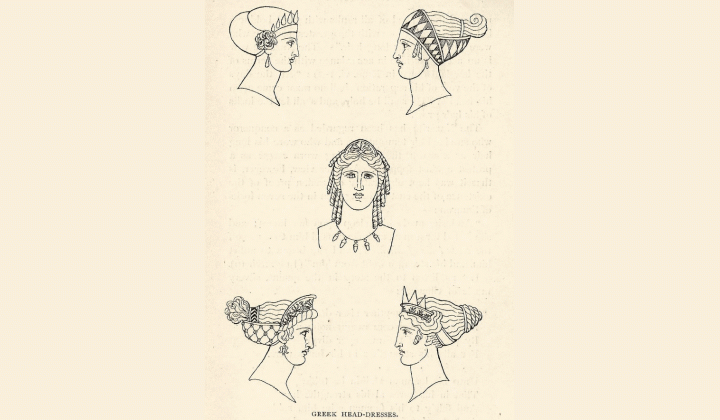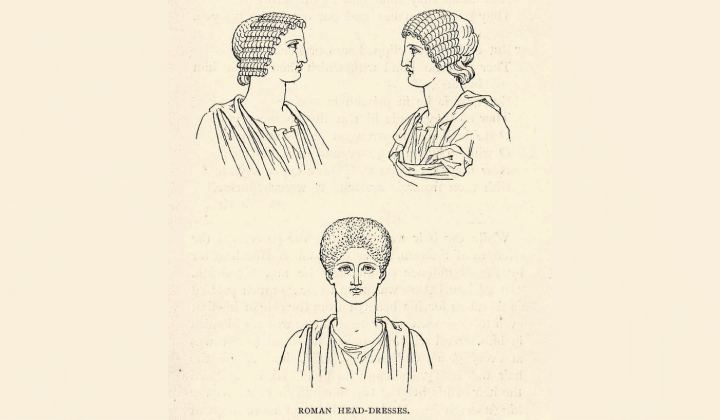The Dressing of the Hair, Moustachios and Beard
Excerpts from "Chats on Costume" by G. Woolliscroft Rhead, 1906There was nothing new, even in the days of Solomon; wigs, curling irons, hair powder, and turned-up moustachios being no exception to the rule.
 We have abundant evidence, both from the concurring testimony of authors and from the
actual works which have come down to us, that heated irons were employed from a very early period for the purpose of curling the hair
and beard. Both with the Assyrians, and the Greeks of the earlier period, the hair and beard were plaited in a series of symmetrical
curls and ringlets, displaying the utmost degree of formality in their arrangement.
We have abundant evidence, both from the concurring testimony of authors and from the
actual works which have come down to us, that heated irons were employed from a very early period for the purpose of curling the hair
and beard. Both with the Assyrians, and the Greeks of the earlier period, the hair and beard were plaited in a series of symmetrical
curls and ringlets, displaying the utmost degree of formality in their arrangement.The hair and beard of Belshazzar when he "made a great feast to a thousand of his lords," and received an intimation of an unpleasant character, conveyed to him in an unusual manner, were certainly curled in such wise, and probably dyed and powdered, as was the custom, the powder, however, being gold instead of flour, as in more recent days. As a matter of fact, gold was employed in various ways as an enrichment to the hair. The Kings of Egypt had their beards interwoven with gold thread.
 Herodotus assures us that the skulls of the Egyptians were much harder than those of the
Persians, owing to the national custom of shaving the heads of their children at a very early age. He adds, " In other countries the
priests of the gods wear long hair; in Egypt they have it shaved. With other men it is customary in mourning for the nearest relations
to have their heads shorn; the Egyptians, on occasions of death, let the hair grow both on the head and face, though till then they used to shave."
Herodotus assures us that the skulls of the Egyptians were much harder than those of the
Persians, owing to the national custom of shaving the heads of their children at a very early age. He adds, " In other countries the
priests of the gods wear long hair; in Egypt they have it shaved. With other men it is customary in mourning for the nearest relations
to have their heads shorn; the Egyptians, on occasions of death, let the hair grow both on the head and face, though till then they used to shave."The ceremonies and customs relating to the beard are innumerable. The management of the beard formed a considerable part of the religion of the Tartars, who waged a long and bloody war with the Persians, declaring them infidels, though in other respects of the same faith as themselves, because they refused to cast their whiskers after the mode or rite of the Tartars.

It has been recorded that the Greeks wore their beards until the time of Alexander, who, fearful lest the length of their beards should prove a handle to their enemies, comrnanded the Macedonians to be shaven, and the first who shaved at Athens ever after bore the addition of xopone (shaven) on medals. Notwithstanding this statement, however, Philip, the father of Alexander, as well as Amyras and Archelous, his predecessors, are represented without beards.

According to Pliny, the Romans did not begin to shave until the year of Rome 454, when P. Titinius brought over a stock of barbers from Sicily. Pliny adds that Scipio Africanus was the first to introduce the fashion of shaving daily. It became the custom to have visits of ceremony at the cutting of the beard for the first time. The first fourteen Roman Emperors shaved until the time of the Emperor Adrian, who discontinued the practice and wore a beard, for the purpose, however, of hiding the scars on his face.
Next Page 01 02 03 04 05 06 07 08 09 10 11 12